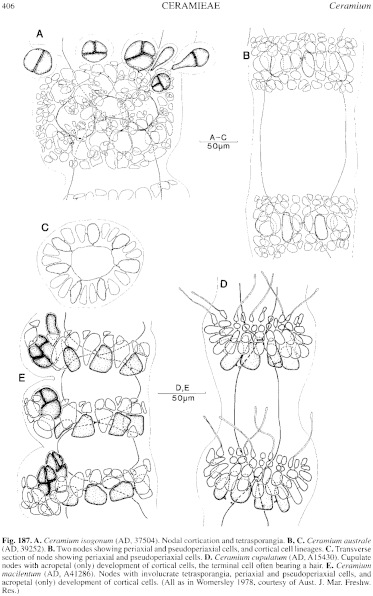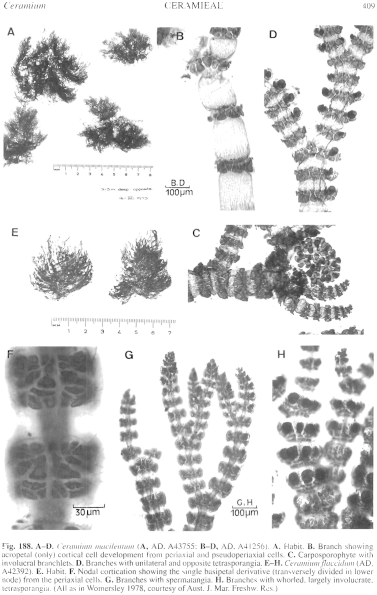|
|
|
|
|
|||||||||||
|
Electronic Flora of South Australia Species Fact Sheet
Phylum Rhodophyta – Order Ceramiales – Family Ceramiaceae – Tribe Ceramieae
Selected citations: De Toni 1903: 1445. Huisman 1997: 197. Lucas 1909: 52. Lucas & Perrin 1947: 365. Millar & Kraft 1993: 39. Price & Scott 1992: 100, fig. 31. Silva et al. 1996: 399. Womersley 1978: 232, figs 3E, 14A–D.
Thallus (Fig. 188A) light red, a few millimetres to 6 cm high, erect or often in tangled masses. Branching subdichotomous to alternate (often every 5–8 cells above) and sometimes tending to be somewhat complanate above, sparse in lower parts, with few if any proliferous branchlets. Attachment by rhizoids of 1–3 uniseriate cells with a multicellular pad, arising usually singly from a periaxial cell of each note of prostrate filaments; on solid substrates, ascidians or epiphytic on various algae. Structure. Branches 70–130 (–150) µm in diameter below, tapering often very slightly to 40–70 µm several cells below the (normally) involute apices. Axial cells L/D (0.5–) 1–1.5 near apices, elongating in larger specimens to L/D 4–6, with a narrow cortical nodal band 30–50 long (Fig. 188B). Periaxial cells usually 6, most of which divide obliquely to form a wedge-shaped pseudoperiaxial cell (Figs 187E, 188B) which interposes between the periaxial cells to form a ring of 10–12 cells; each of these cells usually cuts off one or two cells acropetally, and in older parts these may cut off a further 1–2 cells; the node is thus 2–3 cells long (Figs 187E, 188B); very occasional basipetal cells (Fig. 187E) may be cut off from the periaxial cells but this is rarely found over several nodes or from more than one periaxial cell in a node. Slender hairs commonly present on cortical cells near apices. Rhodoplasts discoid in corticating cells, ribbon-like and longitudinally arranged in axial cells.
Reproduction: Gametophytes dioecious. Carposporophytes (Fig. 188C) with 1–2 irregularly globular lobes, 100–200 µm across, subtended by 2–4 curved branchlets, carposporangia angular, 18–25 across. Spermatangia forming patches on the adaxial sides of nodes, later tending to spread around the node.
Tetrasporangia (Figs 187E, 188D) in prominent, abaxial, unilateral rows (very occasionally in adaxial rows or opposite), usually some distance below the apices, with 1–3 sporangia per node, derived from periaxial cells; tetrasporangia basally involucrate (to half the sporangium) by cortical filaments of a few cells, subspherical to ovoid, irregularly decussately to tetrahedrally divided, 40–75 µm in diameter, with a persistent sheath.
Type from Port Phillip, Vic. (Wilson); holotype in Herb. Agardh, LD, 20616.
Selected specimens: Port Denison, W. Aust., epiphytic, on jetty piles, 0–5 m deep (Kraft, 14.xii.1971; AD, A41179). Mt Dutton Bay, Coffin Bay, S. Aust., 5 m deep (Womersley, 1.xii.1975; AD, A46808). Douglas Bank, N Spencer Gulf, S. Aust., on Solieria robusta, 20 m deep (Johnson, 19.xi.1975; AD, A46700). Port Stanvac, S. Aust., on jetty piles, 5–6 m deep (R. Lewis, 3.ii.1972; AD, A41286). Muston, American R. inlet, Kangaroo I., S. Aust., 2–3 m deep (Kraft, Johnson & Wickes, 16.iv.1973; AD, A43755). Robe, S. Aust., on Gelidium australe, 2–4 m deep (SCUBA divers, 14.ii.1975; AD, A46135). Port Phillip Bay, Vic., on Caulerpa remotifolia, 12 m deep (Macpherson, 18.v.1958; AD, A23169). Crawfish Rock, Westernport Bay, Vic., on Halophila ovalis, 4–5 m deep (Watson, 29.v.1974; AD, A45409).
Distribution: Port Denison, W. Aust., to Port Jackson, N.S.W. and Lord Howe I. (Millar & Kraft 1993, p. 39) and the Great Barrier Reef, Qld (Price & Scott 1992: 100, fig. 31.).
Taxonomic notes: C. macilentum is a slender species which seems well marked by its nodal cortex with the interposed pseudoperiaxial cells and the virtual absence of any basipetal derivatives of the periaxial cells, thus giving a very narrow nodal ring of cells; the unilateral rows of partly involucrate sporangia are also characteristic. There is considerable variation, however, in branching, diameter of the filaments, and degree of extension of the axial cells.
C. macilentum appears to be moderately common in regions of slight water movement. The closest species in southern Australia is the slightly more robust C. cliftonianum, which differs in its much greater cortical development, without pseudoperiaxial cells; occasionally, however, specimens apparently intermediate between them may be found. In the presence of pseudoperiaxial cells, C. australe shows relationship with C. macilentum but differs significantly in the more regular and twinned arrangement of the pseudoperiaxial cells and a more developed cortex, as well as in dimensions and sporangial arrangement.
References:
DE TONI, G.B. (1903). Sylloge Algarum omnium hucusque Cognitarum. Vol. 4. Florideae. Sect. 3, pp. 775–1521 + 1523–1525. (Padua.)
HUISMAN, J.M. (1997). Marine Benthic Algae of the Houtman Abrolhos Islands, Western Australia. In Wells, F.E. (Ed.) The Marine Flora and Fauna of the Houtman Abrolhos Islands, Western Australia, pp. 177–237. (W. Aust. Museum: Perth.)
LUCAS, A.H.S. & PERRIN, F. (1947). The Seaweeds of South Australia. Part 2. The Red Seaweeds. (Govt Printer: Adelaide.)
LUCAS, A.H.S. (1909). Revised list of the Fucoideae and Florideae of Australia. Proc. Linn. Soc. N.S.W. 34, 9–60.
MILLAR, A.J.K. & KRAFT, G.T. (1993). Catalogue of marine and freshwater Red Algae (Rhodophyta) of New South Wales, including Lord Howe Island, South-western Pacific. Aust. Syst. Bot. 6, 1–90.
PRICE, I.R. & SCOTT, F.J. (1992). The turf algal flora of the Great Barrier Reef. Part 1. Rhodophyta. (James Cook University: Townsville.)
SILVA, P.C., BASSON, P.W. & MOE, R.L. (1996). Catalogue of the Benthic Marine Algae of the Indian Ocean. (University of California Press: Berkeley, Los Angeles & London.)
WOMERSLEY, H.B.S. (1978). Southern Australian species of Ceramium Roth (Rhodophyta). Aust. J. Mar. Freshw. Res. 29, 205–257.
The Marine Benthic Flora of Southern Australia Part IIIC complete list of references.
Publication:
Womersley, H.B.S. (24 December, 1998)
The Marine Benthic Flora of Southern Australia
Rhodophyta. Part IIIC. Ceramiales – Ceramiaceae, Dasyaceae
©State Herbarium of South Australia, Government of South Australia
Illustrations in Womersley Part IIIA, 1998: FIGS 187E, 188 A–D.

Figure 187 enlarge
Fig. 187. A. Ceramium isogonum (AD, 37504). Nodal cortication and tetrasporangia. B, C. Ceramium australe (AD, 39252). B. Two nodes showing periaxial and pseudoperiaxial cells, and cortical cell lineages. C. Transverse section of node showing periaxial and pseudoperiaxial cells. D. Ceramium cupulatum (AD, A15430). Cupulate nodes with acropetal (only) development of cortical cells, the terminal cell often bearing a hair. E. Ceramium macilentum (AD, A41286). Nodes with involucrate tetrasporangia, periaxial and pseudoperiaxial cells, and acropetal (only) development of cortical cells. (All as in Womersley 1978, courtesy of Aust. J. Mar. Freshw. Res.)

Figure 188 enlarge
Fig. 188. A–D. Ceramium macilentum (A, AD, A43755; B–D, AD, A41256). A. Habit. B. Branch showing acropetal (only) cortical cell development from periaxial and pseudoperiaxial cells. C. Carposporophyte with involucral branchlets. D. Branches with unilateral and opposite tetrasporangia. E–H. Ceramium flaccidum (AD, A42392). E. Habit. F. Nodal cortication showing the single basipetal derivative (transversely divided in lower node) from the periaxial cells. G. Branches with spermatangia. H. Branches with whorled, largely involucrate, tetrasporangia. (All as in Womersley 1978, courtesy of Aust. J. Mar. Freshw. Res.)

|
Email Contact: State Herbarium of South Australia |

|